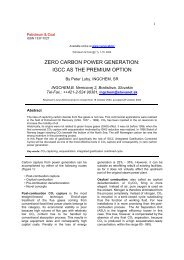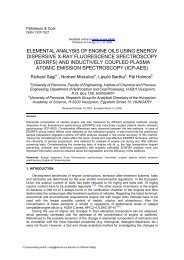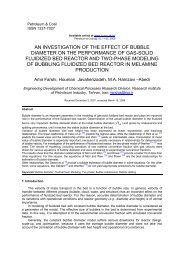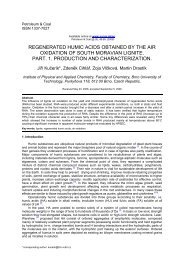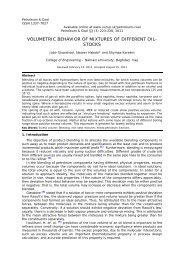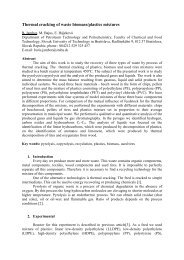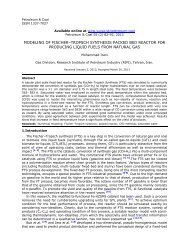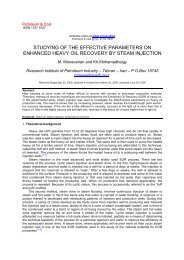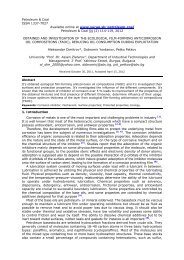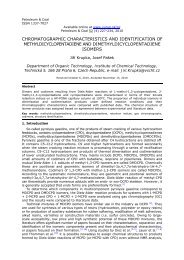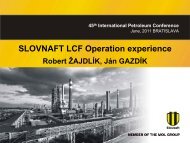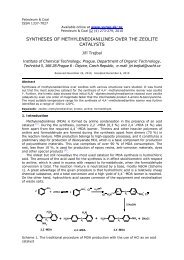Estimation of measurement uncertainty for the determination of the ...
Estimation of measurement uncertainty for the determination of the ...
Estimation of measurement uncertainty for the determination of the ...
Create successful ePaper yourself
Turn your PDF publications into a flip-book with our unique Google optimized e-Paper software.
CountsD:\Analytical\...\Me-Bs-6_111222170734 22.12.2011 г. 17:07:34Fatty acid content, %D. I. Yordanov, Z. B. Tsonev, T. V. Palichev, Z. A. Mustafa/Petroleum & Coal 55(2) 74-81, 2013 79RT: 0.20 - 38.001000000009500000090000000NL:1.34E8FIDAnalogMe-Bs-6_1112221707345045450 W 300 W Dried at 20°C 120-150°C 600W850000008000000040750000007000000015.3735650000006000000019.53305500000050000000450000004000000025203500000030000000250000002000000018.8218.481510150000001000000022.125500000001.335.6710.2522.56 27.1812.12 16.0830.61 34.925 10 15 20 25 30 35Time (min)Fig. 6. GC chromatogram <strong>of</strong> <strong>the</strong> lipid extractfrom c<strong>of</strong>fee residue irradiated by 600Wmicrowave <strong>for</strong> 20 minutes0Fattyacid14:0 16:0 18:0 9-18:1 11-18:1 18:2 18:3 20:0 20:1 21:0 22:0 23:0 24:0Fig. 7. Fatty acid content based on <strong>the</strong> resultsfrom Table 3.From our study and <strong>the</strong> data shown in Figure 7, we observe that any type <strong>of</strong> pretreatment(microwave irradiation or heat treatment only) <strong>of</strong> c<strong>of</strong>fee residue from vending automatincreases <strong>the</strong> amount <strong>of</strong> saturated fatty acids.The palmitic and linoleic acids have <strong>the</strong> highest percentage in <strong>the</strong> analyzed extracts.The amount <strong>of</strong> stearic, oleic and arachidic acids are significant. The percentage <strong>of</strong> all o<strong>the</strong>rfatty acids is less than one.If <strong>the</strong> c<strong>of</strong>fee residue is not processed in any way, <strong>the</strong> greatest is <strong>the</strong> amount <strong>of</strong> unsaturatedfatty acids with more than one double bond. The residue treated at 120-150 C have asignificant content <strong>of</strong> saturated fatty acids and those containing one double bond, and<strong>the</strong>re<strong>for</strong>e <strong>the</strong> least amount <strong>of</strong> fatty acids with two or more double bonds.The c<strong>of</strong>fee residue that was treated at 600W microwave has <strong>the</strong> fatty acid compositionsimilar to those <strong>of</strong> residue processed at 120-150 C. The residue processed at 450W microwaveirradiation has <strong>the</strong> fatty acid composition similar to those <strong>of</strong> residue dried at 20 C. Thesample treated at 300W microwave irradiation has a similar composition as those processedat 450W microwave irradiation.The triacylglycerols have <strong>the</strong> higher content in <strong>the</strong> neutral lipids (over 45%). This rateis <strong>the</strong> lowest in <strong>the</strong> sample that was treated at 120-150 C (46.8%). The residue dried at20 C has <strong>the</strong> highest percentage <strong>of</strong> triacylglycerols (67.1%). The residues dried at 120-150 C and irradiated at 600W microwave have <strong>the</strong> higher percent <strong>of</strong> sterols, diacylglycerols,and free fatty acids in sum.The percentage <strong>of</strong> lipids is calculated from <strong>the</strong> original sample by <strong>the</strong> extraction thatwas made. In our case, when we were added <strong>the</strong> amounts <strong>of</strong> lipid classes and adjustment tolipid extract were obtained <strong>the</strong> percentages <strong>of</strong> dyes, etc. accompanying substances thatdiffer in polarity <strong>of</strong> <strong>the</strong> lipid classes. Based on <strong>the</strong> data from Figure 9 and Tables 5 and 6,we can say that <strong>the</strong> lipid extract derived from <strong>the</strong> processing <strong>of</strong> c<strong>of</strong>fee residue with microwaveradiation power <strong>of</strong> 600W, contains <strong>the</strong> greatest amount <strong>of</strong> lipids (8.07%). This is probablydue to <strong>the</strong> flow <strong>of</strong> high-energy cracking under <strong>the</strong> influence <strong>of</strong> powerful microwave radiationto <strong>the</strong> molecules in <strong>the</strong> c<strong>of</strong>fee residue, resulting in increased total lipid content.Due to <strong>the</strong> higher melting point <strong>of</strong> saturated fatty acids and correspondingly lower oxidativestability <strong>of</strong> <strong>the</strong> unsaturated fatty acids containing one or more double bonds have to find<strong>the</strong>ir balanced composition in <strong>the</strong> production <strong>of</strong> bi<strong>of</strong>uels. The sample obtained at 600Wmicrowave has <strong>the</strong> balanced composition <strong>of</strong> saturated and unsaturated fatty acids <strong>of</strong>approximately 50%. This allows us to <strong>of</strong>fer exactly this way <strong>of</strong> handling <strong>the</strong> raw materialto obtain <strong>the</strong> biodiesel.Table 5. Lipid content <strong>of</strong> <strong>the</strong> extracts from sources irradiated by microwave.C<strong>of</strong>feeresidue,g.Microwaveirradiation,WTime <strong>of</strong>irradiation,min.Rawmaterial <strong>for</strong>extraction,gTime <strong>of</strong>extraction,hProduct, g.Total lipidcontent, %20 600 20 13.7527 2 1.5092 8.0720 450 20 16.4640 2 1.4276 5.9420 300 20 17.7204 2 1.5105 5.63



